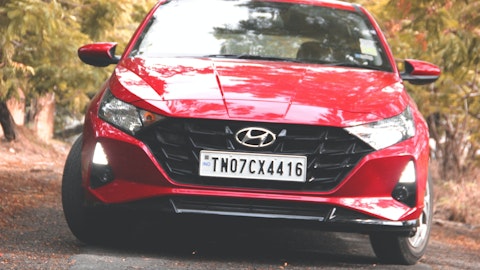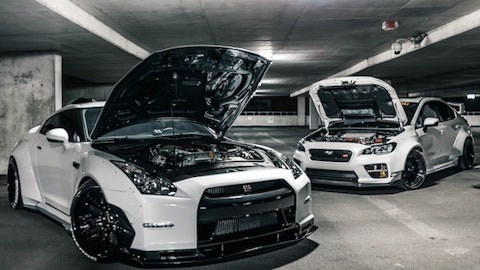Krista Friesen: Great. And maybe just a housekeeping one. Have you seen any sort of supply chain impact from any of the issues going on in the Red Sea right now?
Patrick McCann: Nothing material I would — we haven’t seen really anything material. A lot of the industry disruptions, whether it was chips, we’re probably more into what we would have seen historically for OEMs going down. There’s not a real — it’s very different than it was 18 months ago, Krista.
Krista Friesen: Okay, great. Thanks. I’ll jump back in the queue.
Swamy Kotagiri: Thank you.
Operator: Our next question is from the line of Rod Lache with Wolfe Research. Please go ahead.
Rod Lache: Good morning, everybody. I wanted to ask about just a couple of earnings bridge question. I believe your ADAS business was $1.8 billion, $1.9 billion revenue and a few hundred million dollars loss making in 2023 since your gross profit couldn’t really, at that point, offset the R&D that’s spent in the business, I think it’s about 2/3 of your megatrend spending. Are you still expecting ADAS revenue of $3 billion and EBIT at around breakeven in 2024 and then corporate average margin, ’25?
Swamy Kotagiri: Good morning. Rod, I think we — there’s a couple of things. I think when we talked about Veoneer, one of the key things was being EBITDA neutral in ’24. I think we are on track to get there, and we feel comfortable about it. Looking at the sales for 2024. I think we are on track. They’re still there. And as I mentioned, we are looking at the profitability of our ADAS overall as we look at that segment or that piece of the megatrend. We feel comfortable looking at the spend on the programs that we have — unless the program mix changes. And as you know, we had to still launch the programs and work through the stuff. And if the revenue gets smaller, only based on volumes, it might impact. Otherwise, I think we feel we are progressing from the spend to revenue and towards the profitability in the right way.
Rod Lache: Okay. Yes. I’m just thinking about the midpoint of your revenue and the midpoint of your margin guidance implies about $300 million of earnings growth this year in 2024 versus ’23. And I thought that the ADAS improvement alone, I know you had about $70 million of fee in your synergies, and it seemed like there was a meaningful amount of improvement year-over-year in ADAS? And if you get half of the 75 basis points of performance this year. That’s another $150 million, is there something that I’m missing in terms of the headwinds on a year-over-year basis that brings it back down to about $300 million of earnings growth in ’24?
Patrick McCann: Yeah, good morning, Rod, I think your math, you’re throwing out is in the ballpark for the ADAS business. So I think you’re bang on there. There are a couple of pieces just to consider as well as, when you look big picture, our sales are flat year-over-year, and it’s going to be the third time to say it. I feel like a broken record, but our G-Wagon impact is our sales are up $620 million. So what we are seeing is some volume weakness beyond it given the flat environment. Beyond that, we also then have — we do have continued inflationary headwinds and lower scrap pricing, which has impacted us in the range of about 30 basis points. And then we do have some — then that the positive offset is the operational excellence that Swamy spoke about. And then the last piece really is what you referred to on the ADAS piece and some of the megatrends as the sales grow. So net-net, that works out to your $300 million.
Rod Lache: Okay. And then just lastly, it sounds like you’re not anticipating any recovery on the 30 basis points of higher input costs. Can you just give us a little bit of color because it seems like you had some significant impact in 2021, 2022, you kind of neutralized the headwind in 2023, but had not yet recovered the cost that you had absorbed prior to that. And now there’s — it sounds like there’s another round of material cost headwinds. So on a — just on a very high-level basis, how are you thinking about the recoveries for what you’ve absorbed and these additional headwinds?
Patrick McCann: It’s primarily not material-related headwinds other than the scrap, right? So scrap reprices every month, and it’s just a factor when you’re selling your engineers scrap back into the dealers. But the primary driver of higher cost is the elevated inflation that we’re seeing globally, and it’s driving higher labor rates, Rod. So if you think about traditionally you’d be in North America, whether you’re US or Canada, Germany, Austria, a big regions, you’d be operating pick an number, say, roughly 2% labor inflation on a year-over-year basis. We’re seeing increases that are above that. I would say in North America, so in Canada, US, we’re seeing increases, maybe a couple of points above that. And in Europe, we’re seeing bigger, bigger impacts and it’s primarily driven by the higher energy costs that the local residents are feeling.
So there is embedded inflation through the labor side. The flip side to that is we do have assumed recoveries from our customers to offset those amounts. We’re not taking it lightly. But as Swamy said earlier, the more important thing is how do we become more efficient so that we’re actually changing our fixed cost structure that these labor impacts aren’t as impactful to Magna overall as we go forward.
Rod Lache: Yeah. It makes sense. Thanks for the clarity.
Patrick McCann: Thanks, Rod.
Swamy Kotagiri: Thanks, Rod.
Operator: [Operator Instructions] Our next question is from the line of Brian Morrison with TD Securities. Please go ahead.
Brian Morrison: Thanks. Good morning, Pat, I just want to clarify from a Veoneer perspective, your engineering costs, have they increased or the duration been extended from your prior outlook? And then my second question is I know it’s not typical that you talk about your prior three-year guidance, but you did reiterate your guidance for 2025 back in as late as November. I’m wondering if you can provide us an update on what your outlook is for that or at least the cadence from 5.7% this year to, I guess, a 7.35% in 2026. .
Patrick McCann: Hey, Brian. Good morning. I think two questions. So on the first one being the megatrend engineering spend. So we’re projecting on average $1.2 billion per year over our outlook period. That’s in line with what we provided as an update in September. So it’s really — so last year’s outlook, we had talked about the $900 range. We increased it to $1.2 billion fully to reflect the acquisition of Veoneer. So no change in our engineering profile. When you talk about our 2025 margin from September, I took Krista through the walk. So long story short, when you look at our 2025 numbers, we do see some headwinds related to volumes and some launch cost and new facility costs given some of the recent awards, but it’s partially being offset by operational improvements that Swamy covered in detail.
So the net of those — if you look at our midpoint for ’25, we were 7.35, the impact of those 3 categories is about a 30 basis point negative impact. And then lastly, we have, again, the G-Wagon pricing, which is about a 20 basis point headwind.
Swamy Kotagiri: And just to be clear, when we’re talking about updating ’25, we wanted to make sure we could incorporate the impact of Veoneer incorporate the impact of the amortization. But I think we have a footnote that said that based on the assumptions that we had when we started the year, right, we were in the middle of our business plan and we’re giving that information. Volumes have changed since then. And mix has changed.
Brian Morrison: That’s fair. It just looks like it’s a mid-6 margin for 2025 is what you’re implying. I appreciate it. Thank you.
Operator: Our next question is from the line of Colin Langan with Wells Fargo. Please go ahead.
Colin Langan: Great. Thanks for taking my questions. Any color on your exposure to Fisker? Obviously, there’s some concerns there if something happened, I mean, what kind of sales or earnings impact could you see?
Patrick McCann: Colin, when you think about the exposure, obviously, Fisker is a big customer for our assembly operations. And as far as our exposure to them, we do disclose in our financial statements, our exposure related to all new entrants. And when I talk about exposure, it’s basically related to working capital, long-term assets, dedicated type assets. And the numbers aren’t out, but it’s going to be in the range — that gross number is probably in the range of about $600 million. The majority of that is Fisker.
Colin Langan: Got it. Any — but if sales were to go away too, there’d be some earnings drag, should we be thinking about if there’s a risk there?




